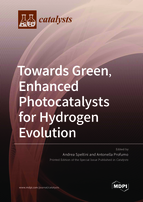Towards Green, Enhanced Photocatalysts for Hydrogen Evolution
A special issue of Catalysts (ISSN 2073-4344). This special issue belongs to the section "Photocatalysis".
Deadline for manuscript submissions: closed (30 September 2020) | Viewed by 25588
Special Issue Editors
Interests: concentration and determination of pollutants in various matrices; hydrogen gas production from water and sacrificial biomasses; application of in lab prepared photocatalysts; recovery of valuable raw materials; chemical characterization of products; ICP-OES and ICP-MS; chromatographic techniques
Interests: environmental analysis; emerging pollutants; carbon materials; sample treatment; renewable energy; photocatalysis; green hydrogen production
Special Issues, Collections and Topics in MDPI journals
Special Issue Information
Dear Colleagues,
The increasing demand for renewable energy sources has in recent years resulted in many efforts towards the usage of hydrogen as a clean energy vector. In this framework, photocatalysis is emerging as a low-cost, clean, and safe technology to perform reactions for a variety of applications, including H2 production from water, only requiring a light source as a driving force, and a suitable semiconductor as a photocatalyst. Several photocatalytic systems have been proposed so far that exploit inorganic catalysts, e.g. titanium dioxide under UV/visible light, but with relatively low efficiency and selectivity towards H2 evolution under solar radiation.
In the last years, great interest has been attracted by organic semiconductors, for instance graphitic carbon nitride materials. The current research in H2 photoproduction is addressed to improving the photocatalytic activity of both conventional and new photocatalysts, to exploit alternative and more sustainable co-catalysts, and to combine different semiconductors in heterojunction systems. Catalyst morphology tuning and surface modification are the key points to enlarge visible light harvesting, minimizing charge carry recombination for a rewarding H2 production. At the same time, the sustainability of the overall process, which would be strengthened by exploiting sacrificial biomass, really deserves more attention.
We invite the submission of original papers reporting on significant advances in the preparation and application of novel semiconductor materials for photocatalytic H2 evolution from water. In particular, papers describing new routes for obtaining nanocomposites with improved photocatalytic activity under solar light and research papers focusing on the development and optimization of hydrogen-producing photocatalytic systems from (waste) biomass are particularly encouraged
Potential topics include but are not limited to the following:
- Synthesis and characterization of new nanocomposite materials for photocatalytic hydrogen production from water
- Investigation of non-noble metals and/or semiconductors as co-catalysts
- Valorization of (waste) biomass as a sacrificial agent
- Development of efficient phototocatalytic systems for H2 production under solar light
- Multivariate approaches for the optimization of H2 evolution
Prof. Dr. Antonella Profumo
Dr. Andrea Speltini
Guest Editors
Manuscript Submission Information
Manuscripts should be submitted online at www.mdpi.com by registering and logging in to this website. Once you are registered, click here to go to the submission form. Manuscripts can be submitted until the deadline. All submissions that pass pre-check are peer-reviewed. Accepted papers will be published continuously in the journal (as soon as accepted) and will be listed together on the special issue website. Research articles, review articles as well as short communications are invited. For planned papers, a title and short abstract (about 100 words) can be sent to the Editorial Office for announcement on this website.
Submitted manuscripts should not have been published previously, nor be under consideration for publication elsewhere (except conference proceedings papers). All manuscripts are thoroughly refereed through a single-blind peer-review process. A guide for authors and other relevant information for submission of manuscripts is available on the Instructions for Authors page. Catalysts is an international peer-reviewed open access monthly journal published by MDPI.
Please visit the Instructions for Authors page before submitting a manuscript. The Article Processing Charge (APC) for publication in this open access journal is 2700 CHF (Swiss Francs). Submitted papers should be well formatted and use good English. Authors may use MDPI's English editing service prior to publication or during author revisions.
Keywords
- Nanocomposite photocatalysts
- Novel photocatalytic materials
- Co-catalysts
- Water splitting
- Solar energy conversion
- Biomass
- Green H2 production







